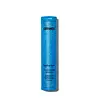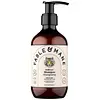What's inside
What's inside
 Key Ingredients
Key Ingredients

No key ingredients
 Benefits
Benefits

 Concerns
Concerns

 Ingredients Side-by-side
Ingredients Side-by-side

Water
Skin ConditioningSodium Cocoyl Isethionate
CleansingCocamidopropyl Hydroxysultaine
CleansingCoco-Glucoside
CleansingGlycol Distearate
EmollientSqualane
EmollientHippophae Rhamnoides Fruit/Seed Oil
AntimicrobialBrassica Campestris Seed Oil
Skin ConditioningSesamum Indicum Seed Oil
EmollientCocos Nucifera Oil
MaskingSodium Hyaluronate
HumectantPolyglutamic Acid
Skin ConditioningSpirulina Platensis Extract
Skin ProtectingCocos Nucifera Water
MaskingEmblica Officinalis Fruit Extract
Skin ConditioningCurcuma Longa Root Extract
MaskingLeuconostoc/Radish Root Ferment Filtrate
AntimicrobialCocamide Mipa
EmulsifyingCoconut Acid
CleansingPolyester-11
Skin ConditioningGuar Hydroxypropyltrimonium Chloride
Skin ConditioningPolyquaternium-7
Polyquaternium-73
Sodium Methyl Cocoyl Taurate
CleansingTetrasodium Glutamate Diacetate
Sodium Benzoate
MaskingSodium Isethionate
CleansingSodium Hydroxide
BufferingSodium Chloride
MaskingCitric Acid
BufferingPotassium Sorbate
PreservativePhenoxyethanol
PreservativeParfum
MaskingBenzyl Benzoate
AntimicrobialHydroxycitronellal
PerfumingLimonene
PerfumingWater, Sodium Cocoyl Isethionate, Cocamidopropyl Hydroxysultaine, Coco-Glucoside, Glycol Distearate, Squalane, Hippophae Rhamnoides Fruit/Seed Oil, Brassica Campestris Seed Oil, Sesamum Indicum Seed Oil, Cocos Nucifera Oil, Sodium Hyaluronate, Polyglutamic Acid, Spirulina Platensis Extract, Cocos Nucifera Water, Emblica Officinalis Fruit Extract, Curcuma Longa Root Extract, Leuconostoc/Radish Root Ferment Filtrate, Cocamide Mipa, Coconut Acid, Polyester-11, Guar Hydroxypropyltrimonium Chloride, Polyquaternium-7, Polyquaternium-73, Sodium Methyl Cocoyl Taurate, Tetrasodium Glutamate Diacetate, Sodium Benzoate, Sodium Isethionate, Sodium Hydroxide, Sodium Chloride, Citric Acid, Potassium Sorbate, Phenoxyethanol, Parfum, Benzyl Benzoate, Hydroxycitronellal, Limonene
Water
Skin ConditioningSodium Cocoyl Isethionate
CleansingAloe Barbadensis Leaf Juice
Skin ConditioningCocamidopropyl Hydroxysultaine
CleansingParfum
MaskingDecyl Glucoside
CleansingLauryl Glucoside
CleansingSodium Lauroyl Sarcosinate
CleansingMaltitol
HumectantXylitol
HumectantXylitylglucoside
HumectantAnhydroxylitol
HumectantCocos Nucifera Oil
MaskingHelianthus Annuus Seed Oil
EmollientPueraria Lobata Root Extract
HumectantBacopa Monnieri Extract
Skin ConditioningEclipta Prostrata Extract
Skin ConditioningPelvetia Canaliculata Extract
Skin ProtectingAegle Marmelos Root Extract
Skin ConditioningCentella Asiatica Extract
CleansingDesmodium Gangeticum Root Extract
Skin ConditioningGmelina Arborea Root Extract
Skin ConditioningOroxylum Indicum Root Extract
Skin ConditioningPremna Serratifolia Root Extract
Skin ConditioningSolanum Indicum Root Extract
Skin ConditioningSolanum Xanthocarpum Root Extract
MaskingStereospermum Suaveolens Root Extract
Skin ConditioningTribulus Terrestris Root Extract
Skin ConditioningOrbignya Speciosa Kernel Oil
EmollientCurcuma Longa Root Extract
MaskingMelia Azadirachta Leaf Extract
Skin ConditioningPhyllanthus Emblica Fruit Extract
HumectantWithania Somnifera Root Extract
Skin ConditioningAstrocaryum Murumuru Seed Butter
EmollientLinum Usitatissimum Seed Oil
PerfumingHibiscus Sabdariffa Flower Extract
Skin ConditioningTrigonella Foenum-Graecum Seed Extract
PerfumingHydroxypropyl Guar Hydroxypropyltrimonium Chloride
Hydrolyzed Wheat Protein Pg-Propyl Silanetriol
Skin ConditioningEthylhexylglycerin
Skin ConditioningPolyquaternium-10
Polyquaternium-7
Glycerin
HumectantCoconut Acid
CleansingSodium Isethionate
CleansingSodium Lauroyl Lactylate
EmulsifyingCoco-Glucoside
CleansingDisodium Cocoyl Glutamate
CleansingGlyceryl Oleate
EmollientCitric Acid
BufferingPotassium Sorbate
PreservativePhenoxyethanol
PreservativeLeuconostoc/Radish Root Ferment Filtrate
AntimicrobialCoumarin
PerfumingWater, Sodium Cocoyl Isethionate, Aloe Barbadensis Leaf Juice, Cocamidopropyl Hydroxysultaine, Parfum, Decyl Glucoside, Lauryl Glucoside, Sodium Lauroyl Sarcosinate, Maltitol, Xylitol, Xylitylglucoside, Anhydroxylitol, Cocos Nucifera Oil, Helianthus Annuus Seed Oil, Pueraria Lobata Root Extract, Bacopa Monnieri Extract, Eclipta Prostrata Extract, Pelvetia Canaliculata Extract, Aegle Marmelos Root Extract, Centella Asiatica Extract, Desmodium Gangeticum Root Extract, Gmelina Arborea Root Extract, Oroxylum Indicum Root Extract, Premna Serratifolia Root Extract, Solanum Indicum Root Extract, Solanum Xanthocarpum Root Extract, Stereospermum Suaveolens Root Extract, Tribulus Terrestris Root Extract, Orbignya Speciosa Kernel Oil, Curcuma Longa Root Extract, Melia Azadirachta Leaf Extract, Phyllanthus Emblica Fruit Extract, Withania Somnifera Root Extract, Astrocaryum Murumuru Seed Butter, Linum Usitatissimum Seed Oil, Hibiscus Sabdariffa Flower Extract, Trigonella Foenum-Graecum Seed Extract, Hydroxypropyl Guar Hydroxypropyltrimonium Chloride, Hydrolyzed Wheat Protein Pg-Propyl Silanetriol, Ethylhexylglycerin, Polyquaternium-10, Polyquaternium-7, Glycerin, Coconut Acid, Sodium Isethionate, Sodium Lauroyl Lactylate, Coco-Glucoside, Disodium Cocoyl Glutamate, Glyceryl Oleate, Citric Acid, Potassium Sorbate, Phenoxyethanol, Leuconostoc/Radish Root Ferment Filtrate, Coumarin
 Reviews
Reviews

Ingredients Explained
These ingredients are found in both products.
Ingredients higher up in an ingredient list are typically present in a larger amount.
Citric Acid is an alpha hydroxy acid (AHA) naturally found in citrus fruits like oranges, lemons, and limes.
Like other AHAs, citric acid can exfoliate skin by breaking down the bonds that hold dead skin cells together. This helps reveal smoother and brighter skin underneath.
However, this exfoliating effect only happens at high concentrations (20%) which can be hard to find in cosmetic products.
Due to this, citric acid is usually included in small amounts as a pH adjuster. This helps keep products slightly more acidic and compatible with skin's natural pH.
In skincare formulas, citric acid can:
While it can provide some skin benefits, research shows lactic acid and glycolic acid are generally more effective and less irritating exfoliants.
Most citric acid used in skincare today is made by fermenting sugars (usually from molasses). This synthetic version is identical to the natural citrus form but easier to stabilize and use in formulations.
Read more about some other popular AHA's here:
Learn more about Citric AcidCocamidopropyl Hydroxysultaine is a synthetic cleansing agent, though it is derived from coconut oil.
It is used to enhance the texture of products by boosting lather and thickening the texture. As a cleanser, Cocamidopropyl Hydroxysultaine is mild.
Coco-Glucoside is a surfactant, or a cleansing ingredient. It is made from glucose and coconut oil.
Surfactants help gather dirt, oil, and other pollutants from your skin to be rinsed away.
This ingredient is considered gentle and non-comedogenic. However, it may still be irritating for some.
Learn more about Coco-GlucosideCoconut Acid isn't fungal acne safe.
Cocos Nucifera Oil is obtained from the kernels of the coconut fruit. In other words, this is coconut oil.
Coconut Oil is rich in fatty acids with lauric acid making up the majority of these. It also contains linoleic acid. Due to this high fatty acid content, coconut oil helps trap moisture and soften skin.
Despite being antibacterial, coconut oil may not be great for acne-prone skin. It is comedogenic and may clog pores. This ingredient may not be safe for malassezia or fungal acne.
Note: Coconut Oil should not replace your sunscreen for UV protection. Studies show it only blocks about 20% of UV.
This oil is non-volatile and has a light scent.
The term 'fragrance' is not regulated in many countries. In many cases, it is up to the brand to define this term. For instance, many brands choose to label themselves as "fragrance-free" because they are not using synthetic fragrances. However, their products may still contain ingredients such as essential oils that are considered a fragrance.
Learn more about Cocos Nucifera OilCurcuma Longa Root Extract is from the spice, turmeric. Besides being a healthy and delicious spice, turmeric also has plenty of skincare benefits. It has anti-inflammatory, antioxidant, and anti-microbial properties.
Turmeric contains curcumin, an antioxidant. Antioxidants help neutralize unstable free-radical molecules. Free-radical molecules may damage your skin's cells and DNA. Curcumin may help with anti-aging.
Curcumin also has anti-inflammatory properties and can help soothe skin and reduce irritation. On top of that, curcumin has been shown to help prevent hyperpigmentation from sun damage.
The anti-microbial property of turmeric can make it effective in treating acne. This property has also been shown to help regulate the production of sebum.
Learn more about Curcuma Longa Root ExtractLeuconostoc/Radish Root Ferment Filtrate is a natural preservative. It comes from fermenting radish roots with a bacteria called leuconostoc.
Leuconostoc comes from lactic acid.
This ingredient has antimicrobial properties and helps prevent the growth of bacteria in a product.
Leuconostoc is used to make the traditional Korean side-dish, kimchi. It is also used to make sourdough bread (both incredibly yummy foods).
Learn more about Leuconostoc/Radish Root Ferment FiltrateParfum is a catch-all term for an ingredient or more that is used to give a scent to products.
Also called "fragrance", this ingredient can be a blend of hundreds of chemicals or plant oils. This means every product with "fragrance" or "parfum" in the ingredients list is a different mixture.
For instance, Habanolide is a proprietary trade name for a specific aroma chemical. When used as a fragrance ingredient in cosmetics, most aroma chemicals fall under the broad labeling category of “FRAGRANCE” or “PARFUM” according to EU and US regulations.
The term 'parfum' or 'fragrance' is not regulated in many countries. In many cases, it is up to the brand to define this term.
For instance, many brands choose to label themselves as "fragrance-free" because they are not using synthetic fragrances. However, their products may still contain ingredients such as essential oils that are considered a fragrance by INCI standards.
One example is Calendula flower extract. Calendula is an essential oil that still imparts a scent or 'fragrance'.
Depending on the blend, the ingredients in the mixture can cause allergies and sensitivities on the skin. Some ingredients that are known EU allergens include linalool and citronellol.
Parfum can also be used to mask or cover an unpleasant scent.
The bottom line is: not all fragrances/parfum/ingredients are created equally. If you are worried about fragrances, we recommend taking a closer look at an ingredient. And of course, we always recommend speaking with a professional.
Learn more about ParfumPhenoxyethanol is a preservative that has germicide, antimicrobial, and aromatic properties. Studies show that phenoxyethanol can prevent microbial growth. By itself, it has a scent that is similar to that of a rose.
It's often used in formulations along with Caprylyl Glycol to preserve the shelf life of products.
Polyquaternium-7 is a light to clear colored liquid. It is commonly found in haircare products for its film-forming and anti-static properties.
According to a manufacturer, it is a non-paraben and specially developed for negatively charged surfactant systems. This makes it a great hairstyle holder and helps to improve wet hair detangling without adding buildup.
Potassium Sorbate is a preservative used to prevent yeast and mold in products. It is commonly found in both cosmetic and food products.
This ingredient comes from potassium salt derived from sorbic acid. Sorbic acid is a natural antibiotic and effective against fungus.
Both potassium sorbate and sorbic acid can be found in baked goods, cheeses, dried meats, dried fruit, ice cream, pickles, wine, yogurt, and more.
You'll often find this ingredient used with other preservatives.
Learn more about Potassium SorbateSodium cocoyl isethionate is a natural ingredient from coconut oil. It is an ultra gentle cleanser that gives a nice foam without drying the skin or impacting the skin barrier.
The amount of foam created depends on the amount of sodium cocoyl isethionate used in the product.
This ingredient also helps improve the spreadability of a product.
Learn more about Sodium Cocoyl IsethionateWe don't have a description for Sodium Isethionate yet.
Water. It's the most common cosmetic ingredient of all. You'll usually see it at the top of ingredient lists, meaning that it makes up the largest part of the product.
So why is it so popular? Water most often acts as a solvent - this means that it helps dissolve other ingredients into the formulation.
You'll also recognize water as that liquid we all need to stay alive. If you see this, drink a glass of water. Stay hydrated!
Learn more about Water